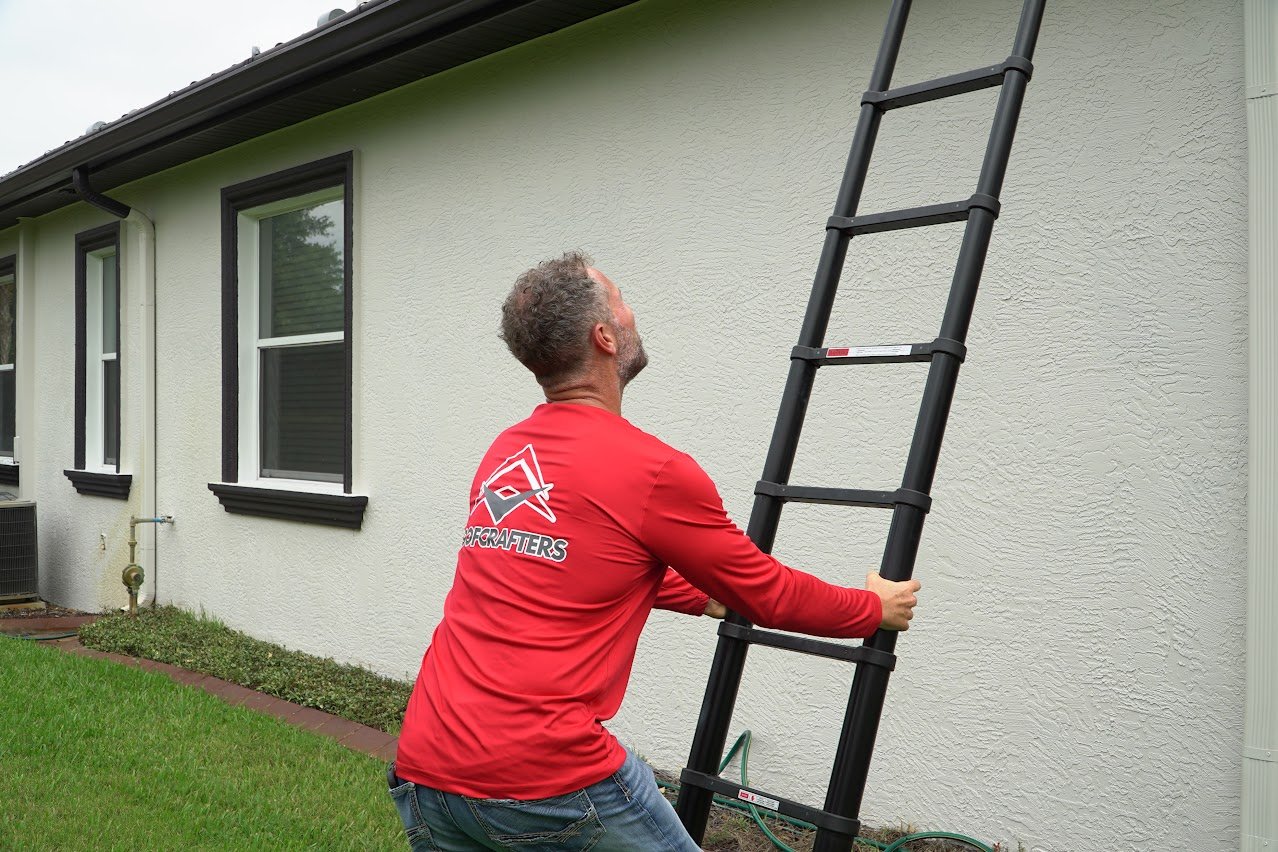
Let’s be honest, cleaning your gutters isn’t exactly the highlight of homeownership. But it is necessary. Clogged gutters can lead to water damage, mold, pest infestations, and even costly roof repairs. That’s right: neglecting your gutters can wreak havoc on your roofing system.
But here’s the kicker: At RoofCrafters, we’ve seen firsthand how cleaning your gutters the wrong way can cause just as much damage as ignoring them altogether. If you’re not careful, you can dent your gutters, loosen fasteners, and even tear up your shingles or underlayment.
That’s why it’s so important to approach this chore with the right tools, techniques, and a whole lot of caution. Whether you’re a weekend DIY warrior or just want to make sure your hired help is doing it right, this article will walk you through exactly how to clean your gutters without damaging your roof. Let’s get into it!
Why It’s Crucial to Be Careful When Cleaning Gutters

Your roof and gutter system work as a team. Gutters collect rainwater and direct it away from your roof, foundation, and siding. But when they’re clogged with leaves, pine needles, or debris, they can overflow, causing water to back up under your shingles, rot your fascia boards, or even flood your crawl space. Improper gutter cleaning, however, can lead to:
- Shingle damage from heavy boots or leaning ladders
- Holes or bends in your gutters from rough scooping
- Loosened nails, hangers, or fasteners
- Water leaks due to punctured roofing membranes
So, how do you avoid all that? You follow this roof-safe gutter cleaning process, of course!
What You’ll Need Before You Start
Before you climb up to tackle your gutters, gather the right tools. Here’s your roof-friendly gutter cleaning checklist:
- A sturdy ladder with standoff arms or a stabilizer
- A ladder helper (yes, really, safety first)
- Work gloves
- A plastic scoop or garden trowel
- A bucket or trash bag for debris
- A hose with a spray nozzle
- Safety glasses
- Non-slip shoes
- Optional: Gutter cleaning attachments for your hose or leaf blower
Important: Avoid using metal tools, pressure washers, or walking directly on your roof unless absolutely necessary. These can damage shingles, flashing, and underlayment.
Step-by-Step: How to Clean Gutters Without Damaging Your Roof

Step 1: Set Up Your Ladder Safely
Use a ladder stabilizer to keep it from resting on your gutters. This prevents denting the metal or pulling the gutters loose from the fascia. Always place your ladder on a firm, level surface and have someone hold it steady while you’re up there.
Pro tip: Don’t lean the ladder against the gutters themselves, that’s a recipe for disaster.
Step 2: Start Near a Downspout
Begin cleaning near the downspout and work your way along the gutter run. This allows you to ensure water will flow properly once you’re done. Scoop out leaves, twigs, and gunk with your gloved hand or a plastic scoop and deposit the debris into your bucket or bag. Don’t try to reach too far. Move the ladder frequently rather than stretching (it’s safer for you and your roof).
Step 3: Use a Hose to Flush the Gutters
Once you’ve removed the debris, use a hose with a spray nozzle to flush out smaller bits and check for clogs in the downspout. This step helps you spot leaks or weak areas without blasting your gutters with too much force.
Avoid pressure washers unless you’re using a specialized low-pressure attachment. High pressure can strip granules off shingles, loosen flashing, or force water under your roofline.
Step 4: Clear the Downspouts
If water isn’t draining freely, your downspouts are likely clogged. Try tapping the side gently to dislodge buildup or insert a plumber’s snake to clear the blockage. Some people use leaf blower attachments, but make sure the force won’t dislodge fasteners or create air pressure under your shingles.
Step 5: Inspect for Damage
Now that everything’s clean, inspect your gutters and roofline for:
- Loose nails or screws
- Sagging sections
- Cracks or holes
- Signs of roof rot or shingle damage
Catching issues early is key, so they don’t become expensive repairs later.
What Not to Do When Cleaning Your Gutters

Let’s run through a few “don’ts” that can cause roof damage during gutter maintenance:
- Don’t walk on your roof unless absolutely necessary. Every step increases your risk of damaging shingles or falling.
- Don’t use metal scoops or tools. They can scrape and dent your gutters or cut into your roofing materials.
- Don’t ignore signs of sagging or leaks. Clean gutters won’t help if they’re improperly pitched or falling apart.
- Don’t clean gutters during wet, icy, or windy weather. That’s asking for a slip-and-fall accident.
- Don’t use harsh chemicals to break up clogs. Many cleaners can damage roofing membranes or corrode metal components.
How Often Should You Clean Your Gutters?

Most experts recommend cleaning your gutters at least twice a year, once in the spring and once in the fall. However, if you live in an area with heavy tree cover or experience frequent storms, you might need to do it quarterly or even more often.
Bonus tip: Installing gutter guards can reduce how often you need to clean, but they don’t eliminate the job completely. You’ll still want to inspect and flush them periodically.
Should You Hire a Pro?
If your roof is steep, your home is multi-story, or you simply don’t feel comfortable on a ladder, it’s worth hiring a professional. Make sure to choose a licensed and insured company that specializes in roof-safe gutter cleaning.
Professional services usually cost between $100–$300, depending on your home size and gutter complexity. That’s a small price to pay compared to thousands in potential roof repairs.
All in all, cleaning your gutters doesn’t have to feel like a death-defying act of courage! With the right prep, tools, and techniques, you can keep your gutters flowing freely without damaging your roof in the process. To recap, here are your key takeaways:
- Use a ladder stabilizer and avoid walking on your roof
- Stick to plastic tools and low-pressure hoses
- Clean near the downspout first
- Watch for damage while you work
- Schedule seasonal cleanings (and more if needed)
Your roof protects everything beneath it. Take care of it, and it’ll take care of you! When you’re ready to jumpstart your next roofing project, whether it be DIY or professional, be sure to schedule a professional roof inspection with RoofCrafters.
My name is Mitch, and I have over 10 years of roofing experience. I enjoy my career in the service industry because I love helping others take care of their homes and businesses. With over 10 years in the roofing industry, my success comes from my honesty and integrity during my roof inspections. I do my best to listen to the needs of my clients and strive to provide an awesome client experience.



